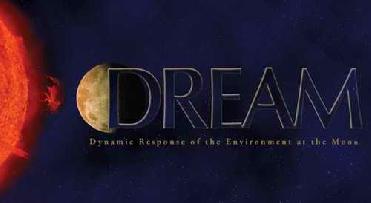
This is the logo for the DREAM project. NASA image
WASHINGTON (BNS): NASA’s Lunar Science Institute has selected Goddard Space Flight Center’s proposal to investigate the sun’s influence on the moon. This research supports NASA’s human exploration of the moon.
Dr. William Farrell of NASA Goddard, Principal Investigator for the proposal, called the Dynamic Response of the Environment at the Moon (DREAM). He said that many people think of the moon as dead, but if one looked with a different pair of glasses - at the atomic level - it was very active. “The sun is constantly throwing energy and matter into space - radiation and a million-mile-per-hour stream of electrically charged particles called the solar wind. If you put an object in the path of this stuff, such as the moon, that object will get hit and react. This reaction to inflowing solar matter includes surface erosion of gas and dust. There are also other subtle reactions, like the electrostatic charging of the lunar surface and any object on the surface that can be a concern for human explorers. All these effects are enhanced during a solar storm when the sun temporarily spews out a greater amount of energy and matter,” Farrell said.
On January 9, NASA announced an award allocating five million dollars grant for four years of research beginning from April. The researchers will build advanced computer simulations to explore the interactions between the sun and the moon, especially emphasising the lunar surface reaction to intense solar storms and impacts from microscopic meteorites and larger objects.
“One of our roles will be to provide modeling support to scientists examining data from NASA's lunar science missions, such as the Lunar Reconnaissance Orbiter. There are always surprises in science, and our computer models can help them understand unexpected results or choose among competing theories,” Farrell said.
According to NASA, DREAM researchers will study different ways the sun influences
the moon, but some interactions will be of special interest to human explorers: solar storms, the electric charging of lunar dust, and the erosion of potential resources at the poles.
“Solar storms are caused by powerful events on the sun, like billion-ton eruptions of gas called coronal mass ejections or explosions equivalent to million-megaton nuclear bombs called solar flares. The reaction of the lunar surface to such events will be studied closely by the DREAM team because they present significant hazards to unprotected astronauts,” NASA said.
The space agency said that firstly, the storms have intense radiation that can cause human sickness. Secondly, they could make the surface electrostatic charging more intense, as they generate strong solar winds along with more intense solar ultraviolet and X radiation. Models of solar storms and their effects on the lunar surface will be developed and applied in the project, NASA said.
“The moon is blanketed in a layer of dust formed by countless impacts from microscopic meteorites. The dust is jagged, like shards of glass, because the moon's atmosphere is too thin to blow it around and grind it smooth like wind does to sand on Earth. Lunar dust might cause health problems if astronauts inhale it, and it could damage sensitive equipment. Solar wind and radiation give dust at the lunar surface an electric charge, so it becomes ‘clingy’, as frustrated Apollo astronauts noted. The DREAM researchers will see if there are places and times where this electrostatic charging is especially severe - like during a solar storm,” the agency said.
Some scientists believe there may be deposits of water as ice, or hydrogen, a component of water, in the bottoms of lunar craters at the poles. These areas may be in permanent shadow and thus extremely cold and able to store ice or hydrogen for billions of years if it was somehow transported there, perhaps gradually deposited by the solar wind or suddenly as vapour from a comet impact. If such deposits exist and it is practical to mine them, they could be a valuable resource because it costs about $50,000 per pound to deliver anything, including water, from Earth to the moon. However, these potential deposits are also exposed to the space environment at the poles, including micro-meteoroid bombardment and solar ion impacts that act to erode the resources.
“DREAM investigators will run models to see how significant this resource erosion could be, especially during storm periods when there is more energy and matter released from the sun. The team will also calculate how rapidly vapour from a comet impact or hydrogen from the solar wind could migrate to the lunar poles,” NASA said.
 Next Article
Next Article













The Indian Air Force, in its flight trials evaluation report submitted before the Defence Ministry l..
view articleAn insight into the Medium Multi-Role Combat Aircraft competition...
view articleSky enthusiasts can now spot the International Space Station (ISS) commanded by Indian-American astr..
view article